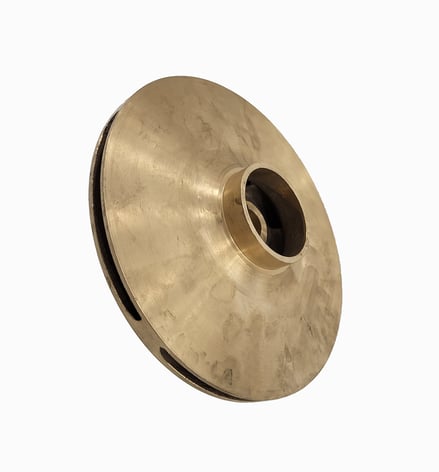In fluid-based HVAC systems an impeller is a component of the pump that creates pressure to maintain flow. In this post we’ll touch on key design aspects of impellers and present answers to the most common questions.
What is a pump impeller for?
In a centrifugal pump, the impeller engages the water from the pump inlet and generates flow by creating pressure in the casing volute. A pump impeller's rotational speed and vane height and depth determine the pump's output pressure and flow.
What are the main types of impeller designs?
Centrifugal pumps, use three main types of impeller designs.
An open impeller design uses only the vanes of the impeller, attached to a hub. Used for liquids with large solids.
A semi open impeller design has the impeller vanes anchored to a disc. Used for liquids with smaller solids.
A closed impeller design places a disc or shroud on both sides of the impeller vanes. Used for clean liquids.
Closed-impellers are installed on radial flow centrifugal pumps and can be either single suction, or double suction. They are ideally suited for pumping liquids with a low percentage of suspended bodies and a low viscosity (resistance to flow). Closed-impellers are also the most efficient type of radial flow impeller, as all the fluid is directed through the channels between the impeller vanes. Impellers in pumps for HVAC applications are usually a closed design with radial vanes.
Single suction (inlet) vs. double suction (inlet) impellers - What's the difference?
Closed impellers can also be found in two different design types. Single suction impellers draw fluid into the impeller vanes from one side only. Double suction impellers draw fluid into the impeller vanes from both sides, balancing out the axial thrust the impeller imposes on the pump’s shaft bearings. Single suction impellers use either balance holes in the back shroud or back vanes on the back shroud, to balance out its inherent axial thrust generated.
How does an impeller work?
The rotation of the impeller creates a negative pressure at the center. This negative pressure draws liquid into the impeller. The liquid is then thrown outwards radially due to the centrifugal force imparted onto it by the impeller.
Why are the vanes of an impeller backward curved?
As water moves through a pump, from the pump inlet, through the casing and out the pump outlet, the fluid flow rate is temporarily increased. As the fluid moves from the eye of the impeller towards the pump outlet the rate of flow must decrease to match the flow levels in the piping. The trade-off that occurs is an increase in pressure in return for a decrease in speed. A backward curving impeller vane makes this tradeoff in a more gradual fashion, which makes the pump more efficient.
What are the most common causes of impeller damage?
When pump impellers become damaged, the most common causes are oxidation and cavitation.
How do I choose a pump impeller?
The choice of impeller is determined by the application and the performance requirements. Flow requirements and the pressure required to produce the required flow are key factors. ADEPT Select is an online tool that makes it easy to size and select Armstrong solutions for fluid flow applications.
What happens when an impeller develops wear?
As the vanes of an impeller wear, both the surface area (shape), and the surfaces of the vanes, change. This reduces the amount of fluid the impeller can move with each rotation, which in turn reduces the ability of the pump to create pressure and the resulting fluid flow.
Product Solutions of Interest:
Vertical In-Line – Retrofit To Design Envelope
Gold Series - Pump Less Volute Kits
Residential Circulators - Replacement Parts Kits
Webinar topics you may also like
Booster Pump Maintenance Basics - Ensure Water Pressure in High Rise Residential Buildings
Fluid Flow, Pump Basics and the Evolution of Smart Pumps
Back to Basics: Variable Speed Pumping and Sensorless Control
Related Case Studies
Detailed answers sometimes need a conversation. Talk with one of our product experts to get answers to your individual questions on impellers.




